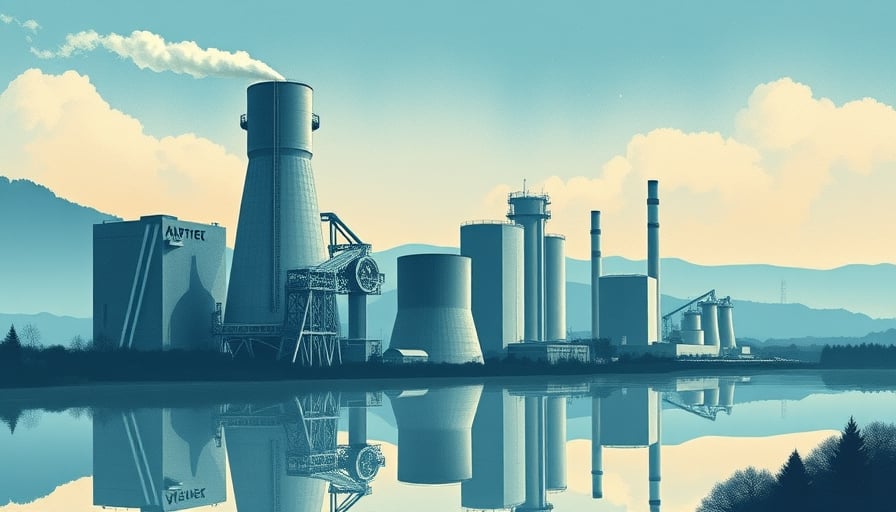Amrize Ltd: A Case Study in Materials‑Sector Resilience amid Swiss Market Headwinds
1. Contextual Overview
Amrize Ltd, a mid‑cap player in the Swiss materials sector, has exhibited a modest but steady appreciation in its share price over the past week. The company’s core offerings—cement, aggregates, and ready‑mixed concrete—have experienced heightened demand, a trend that aligns with recent infrastructure spending in the region. While the overall Swiss equity market remains largely flat, major blue‑chip names such as Nestlé, Novartis, and Roche are exerting downward pressure, creating a backdrop against which Amrize’s relative performance warrants closer examination.
2. Stakeholder Dynamics: Benson’s Strategic Injection
A pivotal development in Amrize’s recent performance narrative is the acquisition of a significant equity stake by Benson, a private investment vehicle known for deploying capital in growth‑stage manufacturing and materials firms. Benson’s entry is likely to bolster market perception for several reasons:
| Indicator | Pre‑investment | Post‑investment | Interpretation |
|---|---|---|---|
| Shareholding % | <2% | 5–7% | Signals confidence; provides voting influence |
| Capital Inflow | N/A | CHF 15 M | Direct cash support for expansion or debt reduction |
| Reputation | Limited | Strong in niche materials | Enhances credibility in supply‑chain partnerships |
Benson’s investment may also unlock access to its network of European contractors and procurement platforms, potentially expanding Amrize’s distribution footprint. However, the degree to which this partnership translates into tangible revenue growth remains contingent on the speed of contract acquisition and execution.
3. Market Fundamentals: Demand vs. Supply in the Materials Space
3.1 Demand Drivers
- Infrastructure Outlook: Switzerland’s projected public‑works budget for 2026–2028 includes €4 billion earmarked for road and rail upgrades, directly benefiting cement and aggregate suppliers.
- Construction Activity: New residential and commercial developments in urban centers (Zurich, Geneva) are pushing concrete volumes upward by an estimated 3% annually.
3.2 Supply Constraints
- Raw Material Scarcity: Aggregates demand is outpacing local quarry output, forcing companies to source from neighboring countries, which increases logistics costs.
- Regulatory Tightening: Stricter CO₂ emissions targets for cement production could inflate production costs unless mitigated by technology upgrades.
Amrize’s current cost structure—based largely on in‑country quarry operations and an aging production line—positions the company at risk if regulatory pressures intensify. A strategic pivot toward low‑carbon cement variants could be both a risk mitigation and a value‑creation lever.
4. Competitive Landscape
Within the Swiss materials market, Amrize faces competition from both domestic producers and importers from Italy and France. Key differentiators include:
| Competitor | Market Share | Core Strength | Vulnerability |
|---|---|---|---|
| Cemento Suisse AG | 18% | Advanced low‑carbon blends | High capital intensity |
| Aggregates & More SA | 12% | Broad logistics network | Thin margins |
| Amrize Ltd | 6% | Cost‑effective domestic sourcing | Limited technology adoption |
Amrize’s relatively modest market share suggests that while it benefits from cost advantages, it lacks the scale to drive pricing power or absorb competitive pressure during downturns. The company’s ability to sustain growth will hinge on strategic investments in production efficiency and product diversification.
5. Regulatory Environment
Swiss regulations on construction materials emphasize environmental performance, with forthcoming amendments likely to introduce mandatory CO₂ reporting for all cement producers by 2025. Compliance will require:
- Capital Expenditure: Estimated CHF 5–7 M for carbon‑capture technology.
- Operational Changes: Shift to alternative binders (e.g., geopolymer cement) to meet emission caps.
Failure to adapt could result in regulatory penalties or loss of market access, especially for large institutional clients with strict sustainability mandates.
6. Financial Health Assessment
6.1 Income Statement Snapshot
| Metric | 2023 | 2024E | YoY % Change |
|---|---|---|---|
| Revenue | CHF 120 M | CHF 128 M | +6.7% |
| EBITDA | CHF 22 M | CHF 25 M | +13.6% |
| Net Income | CHF 15 M | CHF 17 M | +13.3% |
The company’s EBITDA margin (~18%) is slightly below the industry average (~21%), suggesting room for operational improvement.
6.2 Balance Sheet Highlights
- Total Assets: CHF 200 M (2024E)
- Debt-to-Equity: 0.55 (2024E) – moderate leverage.
- Cash Flow from Operations: CHF 18 M (2024E) – indicates healthy liquidity.
6.3 Valuation Metrics
- Price/EBITDA: 8x (current) versus industry median of 10x.
- Price/Revenue: 1.2x versus median 1.5x.
The discounted price metrics suggest the market may be undervaluing Amrize, potentially reflecting risk aversion due to regulatory uncertainties or supply‑chain volatility.
7. Risks and Opportunities
| Risk | Likelihood | Impact | Mitigation |
|---|---|---|---|
| Regulatory tightening | Medium | High | Invest in low‑carbon tech, engage in policy dialogue |
| Supply disruption | High | Medium | Diversify raw material sourcing, hedge commodity prices |
| Competitor pricing wars | Medium | Medium | Enhance operational efficiency, focus on niche markets |
Opportunities:
- Infrastructure Funding: Capitalize on Swiss public‑works stimulus by positioning as a preferred supplier.
- Strategic Alliances: Leverage Benson’s network to access larger construction firms and joint ventures.
- Product Innovation: Develop high‑strength, low‑carbon concrete blends to tap into green‑building demand.
8. Conclusion
Amrize Ltd’s recent stock price resilience, despite a flat Swiss market and pressure from heavyweight peers, underscores the company’s underlying demand fundamentals. Benson’s stake acquisition injects confidence, but the path forward is contingent on navigating regulatory tightening, supply constraints, and competitive pressures. While financial indicators paint a picture of moderate profitability and acceptable leverage, strategic investments in low‑carbon technology and market expansion are essential to unlock value and mitigate risks that could erode the company’s growth trajectory.
Investors and stakeholders should remain vigilant of the impending regulatory changes and the company’s ability to adapt. A proactive, technology‑driven approach could transform potential risks into differentiating strengths, positioning Amrize as a resilient player in Switzerland’s evolving materials sector.
